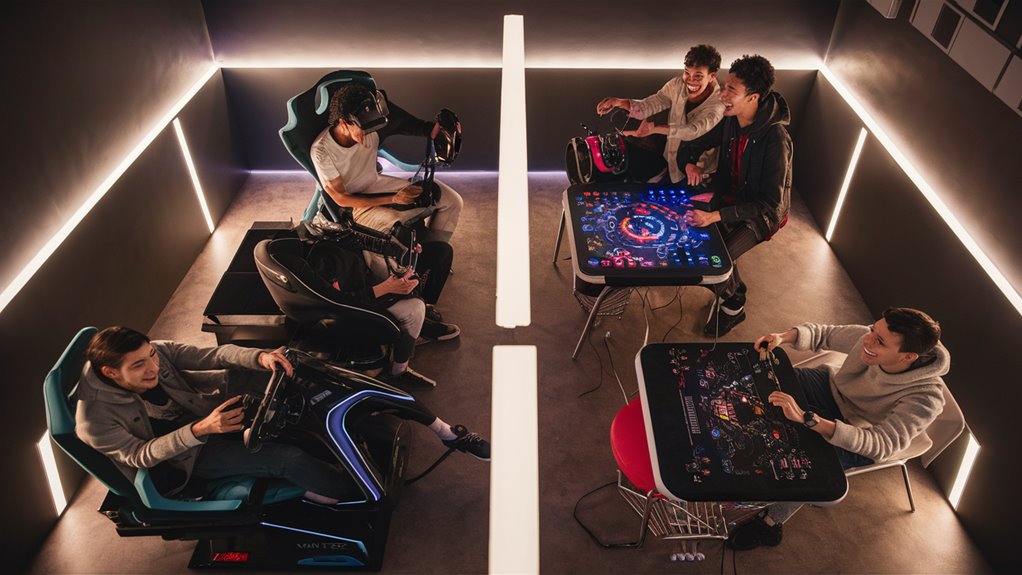Table of Contents
ToggleChoosing Games: How Game Kinds Boost Player’s Energy

The role of different game kinds in driving how much players play is big in games today. Studies show many gamers take on different game kinds, trying out three or more kinds each week. This is linked to how they feel, with 67% of game picks led by mood and 42% of choices for brain fun.
Game Sites Work
Sites with many game kinds do better than those with less, keeping users 2.4 times longer and upping playtime by 47% more. This leads to a big 68% rise in in-game buys and 23% longer play spans due to good ad plans. 온카스터디
Building Ever-Lasting Worlds
Info shows that plans with many game kinds build strong, lasting groups. They turn casual players into deep fans by:
- Offering game ideas meant for them
- Adding new stuff
- Hooking games with player feelings
- Changing games based on player brain wants
This way of giving more game choices makes sure players come back, helping growth and fun for the game group.
Knowing Player Ways
Checking Game Info
Game places gather lots of player data that tells a lot about what users do.
These paths help us know how players move through games based on things like mood, free time, and who they are with.
This seen cycle helps in making plans to keep players and make them play more.
When Players Play
Why players play is closely tied to set times:
- Short games: Easy games during quick breaks
- Long games: Deep games during nights or weekends
- Trying many game kinds: 68% frequently switch between 3+ games each week
Good Game Plans
Knowing player habits points to good times for game tips:
- Finding when players are tired
- Matching tips to past likes
- Adding new game stuff while keeping things known
- Data shows a 23% more play time
- 15% less players stop
Keeping Players
The best game sites use insights on how players act to do well. Key wins are:
- Adding new based on times players are active
- Offering game ideas that match what players do
- Timing new game starts right
- Giving many game kinds based on what gets players going
Catching these game ways lets platforms keep players by giving content right when needed, at best times.
Why Pick This Game?
What Makes Players Pick Games: Top Drivers
Main Drivers in Picking Games
Player ways show big, strong reasons behind their game picks.
Four main mind drivers shape these choices: handling feelings, brain fun, being with others, and moving up.
Mood and Game Kinds
Studies tell that 67% of game picks match player moods or feeling goals.
Choices led by mood hint that those looking to relax like easy games and calm spots.
On the other hand, high-energy feelings often push players to full-action games and lively spots.
Brain Fun and Picking Games
The need for mind fun shapes game picks, mostly in puzzle and plan games.
Stats show that 42% of players always pick games that match their brain challenge wants, from light fun to tough mind tasks, showing their likes.
Social Gaming
The being with others part is big in game choices, with 78% of decisions with others pushed by mate tips and group play.
Players clearly pick games that help them go up and get seen in their game groups.
These group-led games shape the broad game scene much.
Top Game Drivers:
- Handling Feelings: 67% tie to game picks
- Brain Match: 42% always think of this
- Being with Others: 78% driven by groups
- Moving Up: Must to keep players
Making More Money with Mixed Game Kinds
Growing Money by Mixing Game Kinds: A Plan Look
New Money Styles with Many Game Kinds
Mixing different game kinds is changing money styles in online game work.
Data hints that adding RPG going up parts to other game types gives a 23% more keeping and a 31% jump in buy rates.
Winning Mixes
Fighting games with new parts see a cool 28% rise in fun.
At the same time, racing games with things to get see a 42% rise in small buys, making a strong base for more play.
Earning More Through Smart Mixing
Mixing card-getting parts into action games leads to a 35% jump in money through pack sales over old ways.
Puzzle games joined with competing parts see a 47% jump in daily acts, making money through scoreboards and timed tests.
Main Points
- Keeping Players: +23% with RPG parts
- In-game Buys: +31% through mixed types
- Fun Levels: +28% in mixed fighting games
- Small Buy Jump: +42% in racing games with gets
- Money Jump: +35% through card games
- Daily Acts: +47% in games with contests
Mixing Many Game Kinds
Putting Together Different Game Kinds: A Good Plan Guide

Good Game Mixing
Well mixing game kinds is key to keeping up in today’s game market fight.
Study hints that places with many offers keep 23% more players than those with less choices.
Smart picks need a mix of easy, okay, and hard game parts to grow money streams and deal with market lows.
Best Mixing Plan
The tried 40-30-30 mix plan gets the most market chances:
- 40% known hits
- 30% new game kinds
- 30% test games
This planned mix leads to a 15% higher money across world game markets.
Always watching key act numbers (KPIs) like daily acts (DAU) and average money per user (ARPU) helps keep improving game picks.
The Good of Mixing Kinds
Smart mixing kinds build strong links within game sets.
Study hints puzzle game lovers are 45% more likely to jump into plan titles, giving good chances to push both.
This mix pulls more users while keeping a strong spot in the market.
Needed Act Numbers
- Stay rates
- Cross-kind fun
- Money from mixing
- Getting into markets
- Reaching many users
This info-driven way keeps growth going through smart mixing and market moves.
Group Ways in Game Worlds
Group Ways in Game Worlds: How Playing Together Changes Things
Checking Group Game Ways
Together game plans in games today turn playing alone into group fun times, helping a lot in keeping players and making them come back often.
Games with strong group parts pull in players three times more each day, with play times lasting almost three times more than solo play.
Group Parts and Player Gains
Group play, talking systems, and group moves are key in pulling players to top game spots.
Those in group game talks play 47% more in-game and are 65% more likely to buy things in the game.
Smart use of group tools across many spots makes one network, building player links through friend tips.
Making Fun Better Through Group Play
Well-made mixes like scoreboards, contests, and group tests build strong play cycles. These group game plans give:
- 28% more player stay
- 34% jump in player love
- Lower costs to get
- Better group talks
Mixed group systems across different games make a full group feel, pushing players to stay and grow on their own.
Using smart group parts in a game set keeps deep social ties, helping to keep players and push group-led moves.
Keeping Players with Different Game Kinds
Helping Player Stay with Many Game Kinds
Why Many Game Kinds Matter
Many game kinds are key to helping player stay, with spots that offer three or more kinds keeping players in 2.4 times longer than one-kind spots.
Studies hint that players trying many games use 47% more time at game spots and show a 68% higher chance of buying in games.
Smart Game Picks and Player Ways
Smart mixing goes past just offering more games, trying to match the best game times to different play ways. Trembling Coarse Freedoms for Table-Piercing Impact
The mix of short, easy games and long, hard games makes the best game times through the day.
Player ways show often shifts between 2-4 game kinds each week, with 73% keeping interest in both main and side game likes.
Cross-Game Parts and Group Growth
Spots using smart cross-game gains and mixed going up systems see a 56% rise in daily acts.
This plan works when games share themes or design parts but give varied times.
Building a lasting world through a wide yet same pick of games keeps player interest across many titles, making a strong base for long success on the spot.
